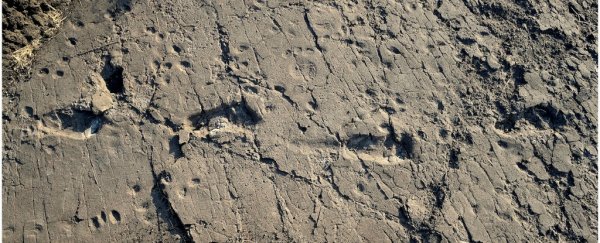A series of 13 fossilised footprints left behind by one of our pre-human ancestors about 3.7 million years ago have been found in Tanzania.
Besides offering us new insight into the evolutionary pathway that made humans the way we are today, the footprints suggest that a pre-human species could have grown to be much taller than previously thought.
According to the team, led by Fidelis T Masao from the University of Dar es Salaam in Tanzania, the prints measure 26 centimetres (10 inches) long. Based on these measurements, the individual who made them would have stood roughly 165 centimetres (5.5 feet) tall, and weighed 45 kilograms (100 pounds).
Here's a different view of them:
 Javed Ahmed et al.
Javed Ahmed et al.
The team has named the mysterious footprint-maker S1, which is also the name of the site in Laetoli, Tanzania, where they were found.
They suspect that S1 belonged to the early hominin species Australopithecus afarensis, but need more evidence before they can say for certain.
If A. afarensis sounds familiar, it's because it's the very same species as "Lucy", the famed set of skeletal remains that were found four decades ago in Ethiopia, providing great insight into our early human ancestors.
But Lucy only stood about 106 cm (3.5 feet) tall, so in comparison, S1 looks like a giant.
"The stature estimates for S1 greatly exceed those previously reconstructed for A. afarensis from both skeletal material and footprint data," the team writes in their paper.
While 165 cm (5.5 feet) isn't exactly tall by today's standards, early human ancestors were not thought reach those heights for another 1.5 million years after the footprints were made.
"Footprints of hominins (namely, the group to which humans and our ancestors belong) are pretty rare. Nearly all of the hominin footprints discovered so far are attributed to species of the genus Homo, to which modern humans belong," says the team.
One of the only exceptions to this is the discovery of three footprints back in the 1970s in the same area, a mere 150 metres (492 feet) away. Those footprints are thought to have been left by the same early hominin species, A. afarensis.
The fact that these new prints hint at such a tall individual could mean two things: either this individual had a rare stature, towering over everyone else; or those heights were not uncommon back then, and we're just now figuring it out.
As the team reports, "Based on the skeletal remains found so far in East Africa, some scholars believe that individuals only varied moderately, as in modern humans, while others state that it was pronounced, as in some modern apes like gorillas."
Little is known about the height differences between male and female A. afarensis, and while the team's findings hint that the footprints were made by a male, there's currently not enough evidence to know for sure.
And not everyone is on board with the team's evaluation of the prints, with some citing the lack of evidence as a reason to take caution when discussing the results, and others, such as Philip Reno from Penn State University, think the find falls in line with how big we previously thought A. afarensis could be.
"I think it confirms about the size we thought the big specimens were," Reno told Malcolm Ritter from the Associated Press.
Despite the conflicting opinions, finding footprints of early humans is always a remarkable discovery that, with further analysis, might shine a new light on our ancestors.
"Fossil footprints are extremely useful tools in the palaeontological record," the team explains. "Their physical features can help to identify their makers, but can also be used to infer biological information. How did the track-maker move? How large was it? How fast was it going?"
Hopefully, as more research is conducted at the Laetoli site, which is proving to be a hotbed for ancient footprints, more details will surface.
The research has been published in eLife.
